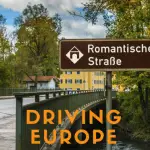In August 2017, my family rented a car in Frankfurt, Germany and spent two weeks driving throughout Central Europe on our European road trip. Our 2-week Europe trip itinerary included the Czech Republic’s Bohemian Switzerland National Park, Krakow’s Wieliczka Salt Mine, and Austria’s Salzkammergut. Thanks to our rental car, we were able to spend the night in city suburbs and rural roadside inns.
Lodging costs in the countryside are just a fraction of what can be found in Europe’s most touristy cities. Besides being able to save a bit of money, we also found ourselves traveling amongst European families on holiday as we stopped at restaurants with playgrounds and hiked trails with educational signs for children. I truly believe that we were able to see a much more family-friendly, authentic side of Central Europe by renting a car rather than relying solely on trains and buses.
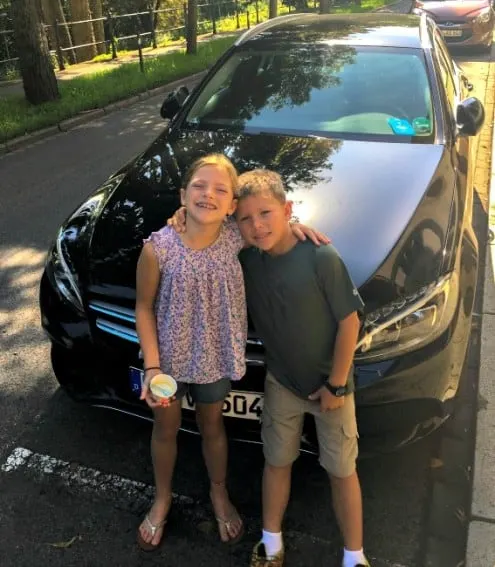
Photo by: Melissa Moore
Why is renting a car in Europe a good decision?
We wanted to travel beyond Europe’s cities more easily on our 2-week Europe trip.
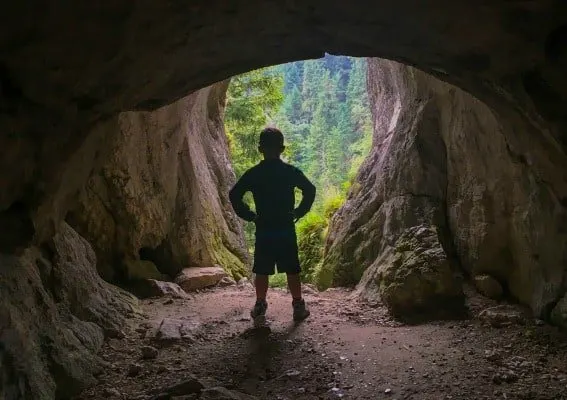
Mylna Cave (Jaskinia Mylna), Tatra Mountains, Poland Photo by: Melissa Moore
I caught the travel bug while traveling Europe in my teens and early twenties. For years, every extra cent of my meager paychecks went almost exclusively to traveling from one European city to another via train while sampling cheese and chocolate and gelato. The history and charm of European cities won me over years before I ever thought of having a family. Then as my children began to toddle around our neighborhood park, I began to dream of returning to Europe with my kids and sharing with them my love of European cities: the artwork, the history, the food.

Salzkammergut Lake District, Austria | Photo by: Melissa Moore
Then my children grew up, and my dream of sharing the cities of Europe with them moved closer to reality; at 7 and 8 they were now old enough suffer through jet-lag without an epic meltdown, big enough to manage their own luggage, and mature enough to order something other than chicken nuggets from a restaurant menu. However, as I began to plan, I realized that these children would not appreciate weeks of jumping from one city to the next the way that I had a decade or so ago. Instead, our 2-week Central Europe trip itinerary needed a more diverse set of destinations: cities, national parks, amusement parks, pools, caves, and even playgrounds rather than cafes, art museums and historic sites.
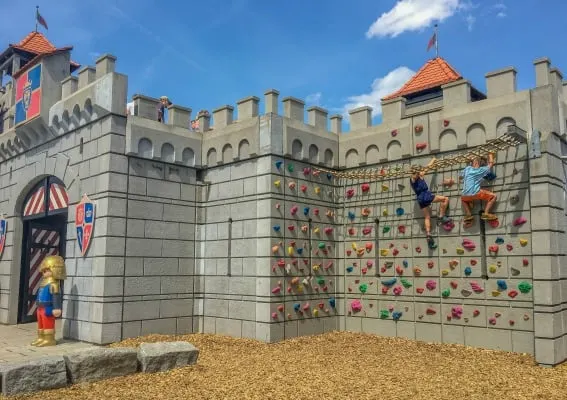
Photo by: Melissa Moore
While it’s lovely to watch the European countryside go by as you to hop from city to city by train, in most cases, it’s harder to get out of Central Europe’s major cities to explore the mountains and small towns than it is when renting a car in Europe. Our family’s very first stop after driving in Germany was Playmobil FunPark (pictured above) located about ten miles outside of Nuremberg. The huge playground amusement park would have been virtually impossible to access via rail so we arrived by car as hundreds of European families do each summer day. The following day we walked a fun labyrinth trail (Felslabyrinth Langenhennersdorf) in Saxon Switzerland National Park (Nationalpark Sächsische Schweiz) alongside dozens of families — another destination only accessible by driving in Germany.
How did we decide what to include in our 2-week Central Europe trip Itinerary?
We sampled a bit of everything that Central Europe has to offer.
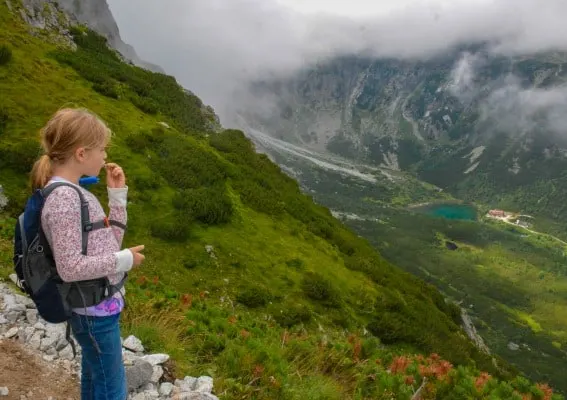
Photo by: Melissa Moore
I have made a habit of traveling with my children for about a month each summer since they were 5-years old. As I compose our itineraries each year, variety is foremost on my mind. And, I’m sure that if your family is traveling for one week, ten days, or a month, the same principle will hold true. As much as my son loves hiking challenging rocky trails and my daughter loves exploring palaces, we simply can’t do those things everyday we’re on the road because we would quickly tire of them and miss out on everything else a destination has to offer. So, no we didn’t tour every royal palace in Vienna — but we did take an audio guide tour of Schönbrunn Palace and spend an afternoon wandering the gardens. Nor did we ride every gondola and climb every mountain in Slovakia’s Tatra Mountains — but we did do an epic full day hike in Vysoké Tatry from Skalnaté pleso up and over a mountain peak to Zelené pleso (pictured above). To develop our 2-week Central Europe trip itinerary, I found things that we love to do and connected the dots.

Photo by: Melissa Moore
This trip we skipped Prague, bypassed most World War II and Cold War era historic sites outside of Munich – especially those related to the Holocaust, and did not tour a single cave in Slovakia (because we had just been to Carlsbad Caverns a few months previous) — you just can’t do everything on a European road trip. But, we did climb to the top of a church tower in Kraków, take a boat ride narrated only in Czech at Adršpach-Teplice Rocks (Adršpašsko-teplické skály), climb ladders over waterfalls in Slovak Paradise National Park (Slovenský Raj), have dinner on a charming town square in Hungary, tour a medieval castle in the rain (Pictured above: Spiš Castle, Slovakia), watch the sun set on Budapest, take a bike tour in Munich, and so much more on our European road trip.
So, did we drive into any major cities on our European road trip?
Yes, we included Kraków, Budapest, Vienna, and Munich in our 2-week Central Europe trip itinerary.
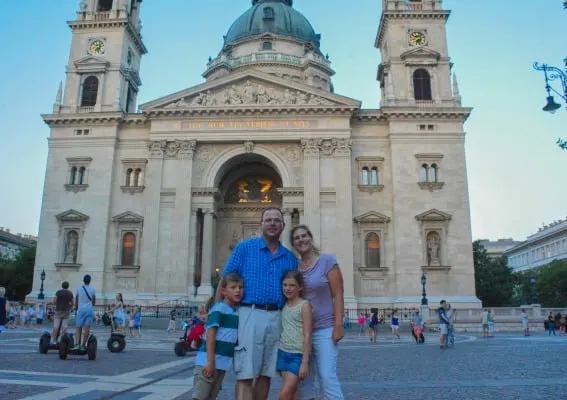
Photo by: Melissa Moore
Of course, our 2-week Europe trip itinerary did include some of Europe’s popular metropolitan destinations, like Budapest (pictured above), Munich, and Vienna. However, our stays in each these cities were brief and the hotels that we chose were generally not within walking distance of the historic city center. We braved the traffic in notably car-friendly, Vienna, parking along the street not far from the center of town We quickly ditched our car in our hotel’s parking garage and took the subway into the city center in Munich and Budapest. Driving in Munich, Germany would have been difficult. When visiting Kraków, we took a different approach, choosing to stay outside the city in a neighboring town and make a day trip into the historic city center by train.
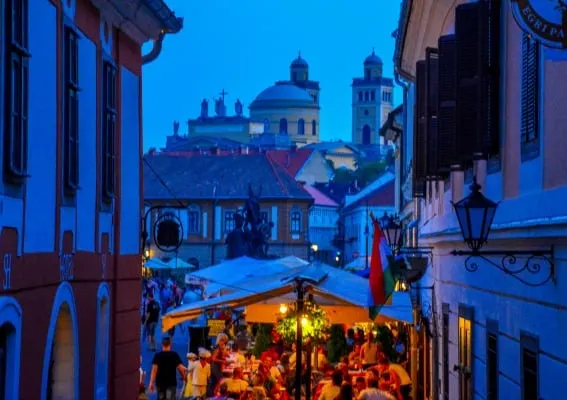
Photo by: Melissa Moore
Honestly, we didn’t miss out on the city experience at all on our European road trip. In the process we also discovered smaller cities like Eger, Hungary (pictured above) and Levoča, Slovakia with beautiful churches, historic city walls, and busy town squares, but few American tourists.
Related: Explore Budget-Friendly Slovakia with your Family
How did we navigate the roads?
Google Maps served us well everywhere we traveled in Europe, especially driving in Germany.

rodelbahn in Salzkammergut Lake Region, Austria | Photo by: Melissa Moore
Traveling domestically I rely heavily on Google Maps; I was optimistic that this would also work for us on our European road trip, and it did. At the time we traveled, our phone plan offered the option of using our regular data and minutes for ten dollars per day in Europe; this seemed to be a fairly universal option in the summer of 2017; my mother, who uses a different US carrier, was also able to opt into a similar plan. While ten dollars a day on cell phone service sounds a bit pricey, it was worth every penny. Certain countries did have more reliable service than others, but I never had to pull out a paper map or stop to ask for directions due to lack of cell phone service.
Google Maps had the added bonus of helping us find ATM machines (Bancomat), gas stations, parking lots, and playgrounds. While driving in Germany and Austria, I found playgrounds for my 7- and 8-year olds by searching for “spielplatz” — playground in German. Once in the mountains, I also began searching for “rodelbahn” — German for mountain coaster or summer bobsled.
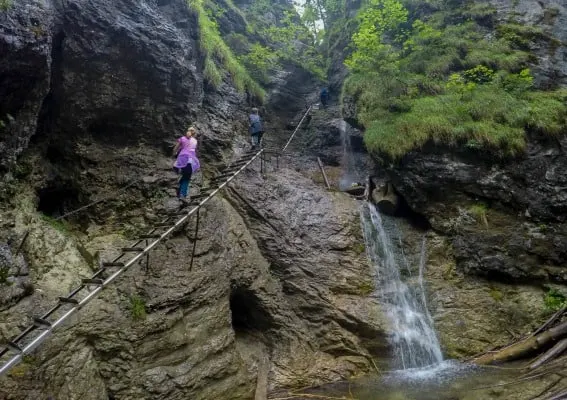
Suchá Belá Gorge, Podlesok, Slovenský Raj, Slovakia | Photo by: Melissa Moore
I admit that I did a lot of research before ever leaving for the European continent on our 2-week Europe trip. I knew the names of the places where I wanted to hike with my family- often having a few choices in each location Being a planner, I had even located many of the trailheads and parking areas on Google Maps before leaving home, marking them with a star so that I could find them more quickly on my phone at a later time. Yes, getting off the beaten path and outside the cities of Central Europe does take more research and planning; while people across the region are friendly and happy to try communicate with Americans in English, it is often difficult to find someone whose English is good enough to give directions or make restaurant recommendations in the more rural areas and smaller cities.
What did crossing the border between countries in the EU look like?
Often nothing more than a blue sign with the EU symbol announcing a country border and a change of cell service on our phone.
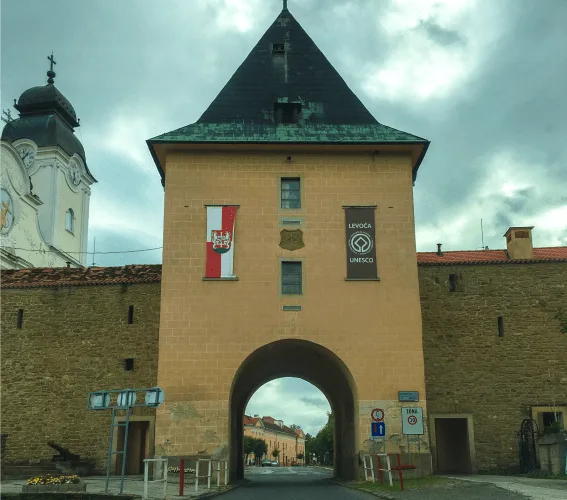
Photo by: Melissa Moore
I’ve crossed the border from the US into Canada and back by road many times over the last 10-20 years. Each time it has involved showing a form of government ID, and when traveling alone with my children, a notarized letter from my husband acknowledging our travel plans. We found each border that we crossed in the EU to be slightly different. Only once did we see guards at a border, and we were never stopped.
Generally, when we crossed a border we saw a blue sign with the EU symbol, and it took at least 10-15 minutes for my phone to switch carriers from the country that we left into the country that we were entering. In addition, we often needed to find an ATM or exchange service to obtain some local currency and a gas station to purchase a vignette for our car to drive on the country’s roads and highways. Vignettes, often a sticker placed on the vehicle’s windshield, are the taxes required to drive on a European country’s roads and/or highways for a specified period of time.
Related: Book a stopover flight and explore Iceland on your way home from Europe

Elbe River Valley, Germany looking towards Czech Republic | Photo by: Melissa Moore
We found it important to have local currency worth at least one hundred US dollars on hand in each of the countries that we visited. The Czech Republic, Poland, and Hungary each have their own currency while Germany, Slovakia and Austria use the Euro. Obtaining currency was particularly difficult in the Czech Republic and Poland where we had trouble finding ATMs (Bancomats) and noted that when we did find them, we had to withdraw more than the equivalent of one hundred US dollars worth of currency. In many countries, it is important to have coins (either local currency or Euros) on hand in order to pay to use the toilets in a public place like a rest stop or gas station.
Each country that we visited handled their road taxes (vignettes) a bit differently. We purchased a vignette immediately upon driving from Germany into the Czech Republic at a roadside store which also offered currency exchange; after a quick five-minute exchange, we were on our way. Road tolls were handled on the highways in Poland causing large traffic back-ups at toll booths on weekends. In Slovakia we had to find a gas station to purchase a vignette upon entry into the country— easier said than done. Hungary’s vignettes were quickly purchased online using the license plate of the car being driven. And, we easily purchased an Austrian vignette at a well-marked rest stop in Hungary prior to crossing the border.
Please remember that this was just our experience in August 2017, it’s important to check on current policies before travel.
All photos by Melissa Moore unless otherwise credited.


